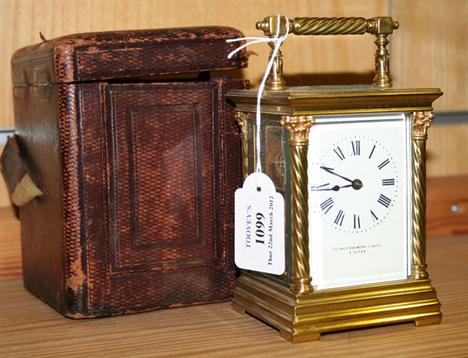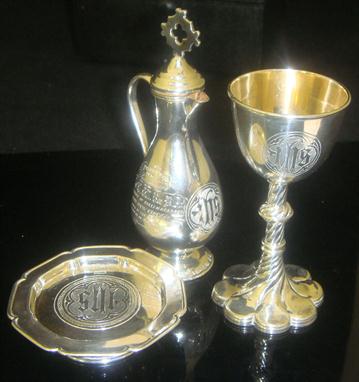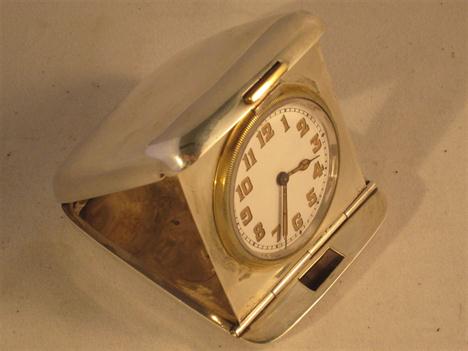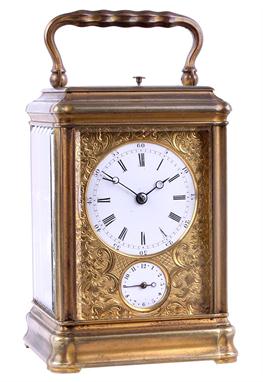We found 5147 price guide item(s) matching your search
There are 5147 lots that match your search criteria. Subscribe now to get instant access to the full price guide service.
Click here to subscribe- List
- Grid
-
5147 item(s)/page
A Grande Sonniere Alarm Carriage Clock with Unusual Seconds Dial and Engraved Case, signed Le Roy & Fils, Palais Royal Galerie Montpensier, 13 & 15, Paris, 296 Regent Street, London, No.6593, circa 1880, the gorge case finely engraved throughout with scroll work decoration, carrying handle and repeat button to the top, bevelled glass panels, the underside with selection lever for petite sonnerie/silence/grande sonnerie, circular white enamel dial signed, unusual positioned seconds dial at 12, alarm dial, twin barrel movement with platform lever escapement, petite/grande sonnerie striking with two hammers onto two polished bells, another hammer striking a bell for the alarm, movement backplate edge signed by the maker and numbered 6593, 17.5cm high over handle, with fitted travelling case see illustration The Leroy family of watch and clockmakers was founded by Basile Charles Le Roy, circa 1785, and continued by his son Charles Louis in 1828 using the name Le Roy & Fils until the end of the century. One of his trading places was at 296 Regent Street London in 1854. See Allix (Charles) Carriage Clocks, pg.444.
An early 20th Century French brass carriage clock with eight day movement striking on a gong, the white enamel dial with Roman numerals and inscribed `Depree Raeburn & Young, Exeter`, the backplate stamped `R & Co, Made in Paris`, the glazed case with spiral reeded carry handle above spiral reeded Corinthian columns on a moulded base and bracket feet, height approx 15.5cm, within leather travelling case.
A Victorian hallmarked silver three piece Priest Travelling Communion Set, comprising wine cruet with matched stopper having engraved presentation plaque with inscription `Presented by the parishioners to the Rev. T W Ros BA incumbent of Ballymacarrett with study clock & C as a mark of the high esteem in which he is deservedly held 1861` and initials IHS, chalice raised on cast column supports and paten, makers marks MT Birmingham and London 1850-1866, fitted in original case, height of cruet 11cm NB: This set are from The Church Of Ireland and are used by a Priest to visit the sick or dying.))
A French gilt brass gorge cased carriage clock with push-button repeat and alarm. Drocourt, Paris, Late 19th century, The eight-day two train gong striking movement with original silvered platform lever escapement with DC trademark for Drocourt and numbered 8749 to backplate, the circular white enamel Roman numeral dial with Arabic five minutes and blued steel Breguet hands set into a foliate engraved rectangular gilt brass mask incorporating subsidiary alarm setting dial to lower margin, the bevel glazed case with hinged carrying handle and repeat serial numbers to base, 13cm (5ins) high excluding handle, with original leather covered outer travelling case.
An extremely rare Charles II travelling timepiece with silent-pull repeat, alarm and calendar. Robert Seignior, London circa 1685, the pierced silver case of later date. The 4 inch diameter circular movement with five finned and knopped pillars secured with blued steel latches to the tulip and foliate trail engraved gilded backplate applied with a scroll pierced and engraved balance cock, double-headed alarm hammer and central bell, the going train with chain fusee and verge escapement regulated by a sprung three-arm flat rimmed steel balance, the silent-pull repeat powered via a standing barrel mounted on the inside of the backplate and now sounding the hours only on the bell mounted to the rear of the movement, the alarm with further standing barrel mounted on the frontplate and crown wheel for the dumb bell type hammer sounding on the same bell, the 4.5 inch circular gilt brass dial with recessed silvered alarm disc, ringed winding hole and calendar aperture to the matted centre within silvered Roman numeral chapter ring with quarter hour inner track, stylised fleur-de-lys half hour markers, Arabic five minutes within the narrow outer track and signed Rob.t Seignior, Londini Fecit to lower edge, with pieced blued steel hands and herringbone engraved outer border, now in a silver case of later date finely pierced and chased with panels in the Renaissance style with scrolling acanthus incorporating figural terms and grotesque masks, putti and squirrels divided by repeating borders including a pair of profile portrait medallions, the hinged front cover with convex glass within foliate cast bezel, opposing hinged rear cover relief decorated with a bathing scene with an old man attended by semi-clad female figures within elaborated pierced double border, the top fitted with a ball pivoted cast suspension ring, (repeat work formerly sounding the quarters on a second bell), diameter 13cm (5ins) overall depth 10cm (4ins). Robert Seignio(u)r is recorded in Loomes, Brian The Early CLOCKMAKERS of Great Britain as apprenticed to John Nicasius gaining his Freedom of the Clockmakers` Company in 1667. He worked in Exchange Alley and was often at loggerheads with the Clockmakers` Company. In August 1674 he was appointed the King`s Clock and Watchmaker `without fee` until the death or surrender of office by Edward East, presumably to ensure succession of the role in the event of East`s demise. This appointment was never formally fulfilled as East outlived Seignior who died in 1687. The current lot is a particularly rare model as it is neither a table clock suitably adapted and scaled for travelling purposes, or a large clock-watch as the scale of the movement and details in construction and design are more akin to clockmaking practice rather than watchmaking. The design and layout of the repeat work closely resembles the earliest silent pull mechanisms first used by leading makers such as Joseph Knibb (See Allix, Charles and Harvey, Lawrence Hobson`s Choice pages 36-41 for closely related table clock repeat work). The engraved decoration to the backplate is again closely related to designs found on contemporary table clocks by the leading makers and can be directly compared to an example by Seignior dated to around 1680 illustrated in Dawson, Percy G., Drover, C.B. and Parkes, D.W. Early English Clocks Plate 512 (page 359). The design of repeat work, style of movement pillar, backcock, engraving and other features such as the distinctive `S` scroll shaped cocks for both the alarm going train crown wheel lower pivots identify the movement and dial of the current lot as unmistakenly English. However two similar travelling timepieces by the Hague maker Johannes Van Ceulen are known. The first example is illustrated in Bruton, Eric THE HISTORY OF CLOCKS AND WATCHES page 173, this appears to be an alarm timepiece only and is housed in a plain drum shaped case with a foliate pierced band towards the rear to allow the alarm to be heard. The case may give an impression of how the original for the current lot may have appeared (the present fine purpose-made elaborately chased and pierced silver case is probably Continental and of later date). The second example is illustrated in Bertele, Hans von MARINE & POCKET CHRONOMETERS and is described as a `ship`s cabin clock`. This second example is generally a more complex model as it appears to strike, have a calendar dial as well as an alarm, and is housed in a more elaborate silver case with pierced decoration to rear cover. The original client for the current lot must have been an extremely wealthy individual to be able to afford the luxury of such a fine timepiece exclusively for travelling purposes. Furthermore a subsequent owner must have also valued it highly enough to commission such a fine purpose-made silver case to be supplied to house the movement and dial.
-
5147 item(s)/page


















































